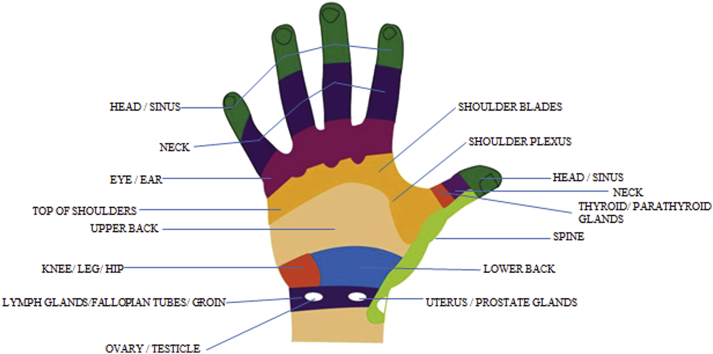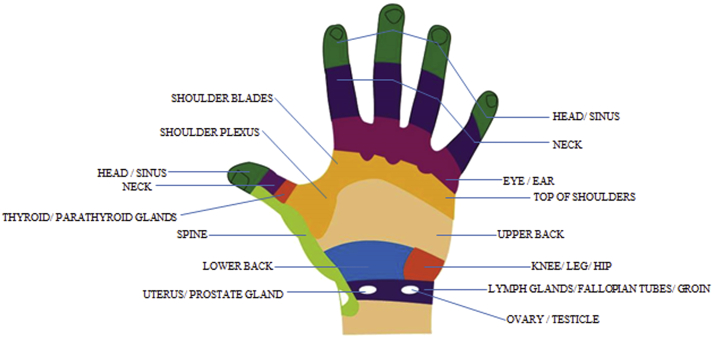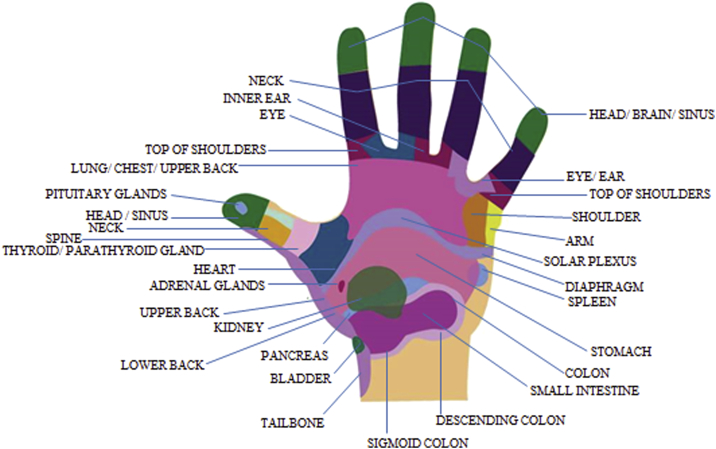September 2015
Nurul Haswani Embong, Yee Chang Soh, Long Chiau Ming, and Tin Wui Wong
Abstract
Reflexology is basically a study of how one part of the human body relates to another part of the body. Reflexology practitioners rely on the reflexes map of the feet and hands to all the internal organs and other human body parts. They believe that by applying the appropriate pressure and massage certain spots on the feet and hands, all other body parts could be energized and rejuvenated. This review aimed to revisit the concept of reflexology and examine its effectiveness, practices, and the training for reflexology practitioners. PubMed, SCOPUS, Google Scholar, and SpringerLink databases were utilized to search the following medical subject headings or keywords: foot massage, reflexology, foot reflexotherapy, reflexological treatment, and zone therapy. The articles published for the last 10 years were included. Previous systematic reviews failed to show concrete evidence for any specific effect of reflexology in any conditions. Due to its non-invasive, non-pharmacological complementary nature, reflexology is widely accepted and anecdotal evidence of positive effect reflexology in a variety of health conditions are available. Adequate training for practitioners is necessary to ensure the consistency of service provided.
Keywords: Complementary and alternative medicine, Treatment effect, Foot massage reflexology, Pain management, Zone therapy
Introduction
Reflexology is a systematic practice in which applying some pressure to any particular points on the feet and hands give impacts on the health of related parts of the body.1 Each point of the pressure acts as the sensors on the feet and hands and is links with different parts of body specifically.1 These sensors will be stimulated by applying the reflexology technique in order to improve the blood and energy circulation, give sense of relaxation, and maintain the homoeostasis.2 Reflexology session can be improved by other elements such as aromatherapy, peaceful music, and good environment settings.3 There is a term in reflexology called reflex zone therapy. Reflex zone therapy is where the body is divided into ten longitudinal zones from head to toe. In the reflex zone therapy, there are five zones on both sides of the body in which each zone diverge down the particular arm, and also continue straight down the body and down the particular leg to line up with a toe on the respective foot. Practitioners usually choose the suitable technique to be applied to the reflex zone therapy to gain optimized efficiency and impact. Reflexology is a complementary therapy instead of an alternative therapy to other treatments which patient already has based on reflexology maps.2 Complementary therapies nowadays are applied in many of palliative care or to alleviate a problem without dealing with the underlying cause in order to make patient's emotional, physiological, and spiritual health improve and increase the value of their life.4 Two methods of reflexology that have been accepted internationally are Ingham method and Rwo Shur method. The first method does not use any tools in its practice and the second method utilizes the use of tools such as a wooden stick.2 There are five theories that support how reflexology gives impacts to body health.5 First and second basic theories are related to energy. Energy theory advocates that body parts can communicate using electromagnetic fields and the communication can be blocked based on the surrounding respectively.6 Third and fourth theories indicate that energy flow can be restored and the fourth is about the pathway which is blocked can be opened.7 The last theory proposes that reflexology can break up the lactic acid crystal that usually deposited in the feet and allow energy to flow efficiently.5
Modern reflexology technique has been used since 60 years ago and now more scientific and clinical research have been conducted because of their positive effects in reducing and alleviating the symptoms associated with certain diseases. Reflexology gives benefits to certain groups of people and generally does not cause any harmful effects as long as certain precautions are taken by the patients with certain medical circumstances. Each person has a different body system condition, so results from reflexology treatment could differ from one person to another.8 Based on latest research conducted, reflexology seems to be effective in helping the body systems to return to its natural state.1 One of the most significant current discussions in reflexology is its effectiveness in tackling several symptoms of diseases.1 The level of disease conditions and pain are reduced as the patients receive reflexology treatment. It has been suggested by a Swiss study that patients who have undergone reflexology sessions showed a significant decrease in the amount of medication needed.1 As a complementary therapy, reflexology seems to work better with conventional treatment to treat certain diseases.8 The most significant current discussions in reflexology practice are related to the aspect of health, safety, and hygiene. Other than that, the principles and practice of reflexology as a complementary therapy is important to make sure the application of this therapy is reliable.
History of reflexology
Earliest discovery of reflexology was found in Egypt based on the observation of daily life activities including the medical practices.1 Other studies have reported that reflexology emerges from China for the last 5000 years ago but there is no documentation found, so with the finding of hieroglyphic mural in the pyramid located in Saggara, reflexology is considered as a part of Egyptian culture from 2330 BC.3 At the late of 14th century, reflexology was already applied throughout the Europe with another name; zone therapy.9 Father of modern reflexology, Dr. William Fitzgerald (1872–1942) has discovered that zone therapy has been used by Aboriginal American.9 Jenny Wallace from North American Indians tribes used pressure at the feet as one of the sources of healing process.9 Fitzgerald study has brought reflexology practice to be widely used in the United States.3 The discovery of zone therapy was developed from the finding of pressure applied on many parts of body such as hands, nose, ears, and many more can relieve pain sensation.10 Dr. Joe Shelby Riley from Washington has conducted many studies of therapy including reflexology and has used this therapy for many years.9 Eunice Ingham (1879–1974) has worked together with Dr. Riley in 1930's as the therapist and work greatly to help people understand reflexology.8 She shared the technique of reflexology with others by writing many books such as “Stories the Feet Can Tell, Stories the Feet Have Told, and Stories the Feet Are Telling”.9 Reflexology has greater recognition after the emergence of another eminent woman in this therapy world with her book; “Helping Yourself with Foot Reflexology” which reached more than 500,000 copies sold.9
Benefits of reflexology
Reflexology has been chosen by most people to treat their body health problems because it offers high level of safety and effectiveness. It also offers natural treatment without consuming drugs and it is easy to use.1 Learning reflexology and its application is quite easy, there is no limitation for people to apply it anytime and anywhere.1 Its effectiveness in treating the root of some diseases may lead to many benefits in health concern such as it helps in easing day-to-day stresses and alleviates the effects from injury and illness.1 However, it is not used in diagnosing processes.11
Stress contributes up to 80% for the development of any illness. Other 20% of stress will influence other conditions.1 Reflexology offers common benefits and one of them is reducing stress by applying pressure to the specific area at feet and hands which may induce general relaxation while relaxing the targeted area concurrently.1 Reflexology is one of the ways to interrupt the pattern of repetitive stress that people usually have according to their lifestyle.1 They will operate more effective with a number of reflexology sessions because the first application will intervene the stress operation and further sessions will improve the body condition.1 Besides, reflexology also allows the body to get off from any stress in everyday life.1
Pain is a stressor in the body system and any injury occurs to any part of the body will cause the whole system to be stressed.1 Endorphin is a body's natural pain-relieving chemical will be released as a response to reflexology. Endorphin teaches the body how to adapt any injuries. Those who practice reflexology in their life believe that healing from any injuries comes from the role of reflexology.3
It generally improves body health condition and well-being in terms of physical, emotional, and spiritual level.11 In simple sentence, people choose reflexology because
1. The treatment is free from any drugs and chemical, and it is a wide option for many health problems.1
2. Its ability to reduce pain.11
3. It helps body to maintain the dexterity and locomotion ability.8
4. It promotes general sense of relaxation especially overused or tired hands, feet, and the whole body parts.2
5. It stimulates the release of body's pain-relieving chemicals.1
6. As a prevention from any illness.2
7. It promotes recovery process from any injury particularly at any region at hands and feet.1
Maps of reflexology
Different maps representing the body reflex areas on the palms and feet are presented in this section.
A series of banded reflex area on the top of the left hand represents the left hand side of the body from the top left side of the head to the knee. Specifically, reflex area for lymph glands, groin, and fallopian tubes encircled the wrist1 (Fig. 1).

This reflex area represents the right side of the body. There is an invisible point at the base of the hand's long bones which is called as waistline.1 This line divided the hand into two parts. The upper back reflex area lies on the above of the line whereas lower back, hips, and internal organs located below it1 (Fig. 2).

This reflex area is related to the left side of the body. Reflex area of the spine lies inside whereas the shoulders are positioned outside.1 The head and neck reflex area are located on the fingers with the tailbone near the wrist1 (Fig. 3).

Different applications of reflexology and the effects of reflexology
The findings by a recent study have confirmed the efficacy of reflexology by recording 31% of pain reduction among the patients with back pain. Quinn et al. reported that the pain intensity score decreased to an average extent in the experimental group.23 Poole et al. demonstrated that there was a significant difference between the control and experimental groups before and after the reflexology treatment.24
A statistic has showed that there are more than 5000 registered reflexology centres in Malaysia. Currently, reflexology is a big industry in Malaysia with a huge unexploited potential for tourism and human capital, especially for disabled people. Owing to that, Ministry of Health has published the good practice guidelines for reflexology in 2011 to strengthen and govern its operations.2 Different use of reflexology and the effect of reflexology are listed below:
1. Low back pain management
A study by an author found that patients who suffered from low back pain usually show good effect in terms of their pain management when they have reflexology as the complementary treatment.25 In this study, the author used VAS scores to indicate the level of pain of the patient. The author added that this complementary treatment can be used as one of the treatment to reduce low back pain but further study on it must be conducted.23
2. Migraine/headache
Patients were referred to a physiotherapist for the six months and the effect of the therapy was recorded by several methods such as qualitative interviews, headache diaries, and questionnaire. The results came out with 55% of them experienced relief, 23% expressed no further recurrence of symptoms, and the rest 11% stopped taking their medications.26
3. Stroke
Stroke is the condition where the blood supply to the brain is interrupted because of some reasons that may cause many health problems.27 It usually occurs due to blood vessels ruptures. Many patients have tried reflexology as the alternative therapy in order to recover from strokes. The practitioners believe that pressure that they exerted on a particular point on reflex areas may induce a positive outcome and physical changes to the body.28
4. Stress reduction
In 2000, Hayes and Cox published a paper in which they described that there are significant reduction in stress in which can be determine by measuring the heart rate, respirations, and mean atrial blood pressure of the patients who have about two to three sessions of five minutes foot massage.29
5. Multiple sclerosis
An author found that a patient who afflict multiple sclerosis and choose reflexology as the complementary treatment for a period of time had notable symptom relief. It is measured by considering urinary symptoms, parenthesis, spasticity, and muscle strength as the parameters. All parameters showed a remarkable improvement except for muscle strength.30
6. Peripheral neuropathy in diabetes mellitus
Previous research has showed that reflexology can reduce the peripheral neuropathy of a patient who suffers from type 2 diabetes mellitus.31 76 patients ranged from 40–79 years old were listed from public health centres in Busan City. Tactile response to monofilament and intensity of the symptoms of peripheral neuropathy were used as the variable outcomes in this study. Tingling sensation and pain were reduced and tactile was more sensitive to 10 g force monofilament.32 The author added that the reflexology can be used as one of the interventions for encouraging foot care in patients who have diabetes mellitus.32 It also can be measured based on glycaemic control and nerve conductivity which show improvement with reflexology.31
7. Asthma
20 asthmatic patients were chosen to be the subject for active treatment and another 20 patients were chosen to have reflexology session. According to a recent research conducted by the author, there are no significant differences between the groups having active session and placebo session of reflexology.33 However, when the analysis of the symptoms diaries was carried out, the results showed that there were significant differences between both groups especially when it was conducted together with subconscious unblinding pattern of study.33
Evidence-based practice
From ten systematic reviews, it is safe to conclude that until now reflexology does not have sufficient evidence to support its clinical use.
There are also many conditions of patients where we need to avoid applying reflexology because it will give unwanted adverse effects.
1. Pregnancy but only for the first trimester period
Practitioners may be accused to have caused the case if there is unlucky miscarriage after the therapy. So practitioners must take the precaution steps by avoiding patients in their first trimester of pregnancy.
2. Diarrhoea and vomiting
Reflexology may cause overstimulation of the body system and may exasperate the condition of the infections. {Traditional and Complementary Medicine Division, 2011 #340}
3. Localized skin disease at hand, feet, and ears
Hand, feet, and ears are the area of reflexology. If there are infections on this area, reflexology can be hurtful and exasperate the existence conditions.2
4. Localized inflammation or swelling of the feet, hand, and ears
Similar situation will happen as the skin diseases worsen due to the practitioner's hand or finger motion on the area of therapy.2
5. Fever and any infectious diseases whether systemic or localized
In order to fight the infection, the body system which is already stressed will be over stimulated in the patient who suffers from any infections and at the same time having this therapy.2
6. Continuing extreme negative reaction to reflexology
If the patient feels uncomfortable and their body health continuously worsens after having this therapy, it is advisable to reconsider the suitability of reflexology for the client.2
Conclusions
Reflexology practitioners and the professional association have advocated that reflexology is effective for general well-being maintenance and treatment of chronic diseases such as strokes, musculoskeletal disorders, and stress. Due to its soothing massage and non-drug complementary nature, reflexology is widely accepted by general public. Yet, numerous systematic reviews confirmed that strong evidence of the positive effects of reflexology postintervention are lacking despite plenty reported small-scale trial and anecdotal evidence of reflexology for some common ailments. Adequate training of practitioners and reflexology programme accreditation are to ensure correct and consistent services are provided.











